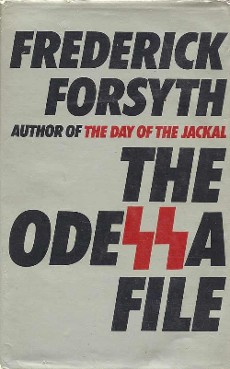Plot
In November 1963, shortly after the assassination of John F. Kennedy, Peter Miller, a German freelance crime reporter, follows an ambulance to the apartment of Salomon Tauber, a Holocaust survivor who has committed suicide. The next day, Miller is given the dead man's diary by a friend in the Hamburg police. After reading Tauber's life story and learning that he had been in the Riga Ghetto commanded by Eduard Roschmann, Miller resolves to search for Roschmann, whom Tauber recognised a few days earlier, alive and prosperous, in Hamburg. Miller's attention is especially drawn to one passage in which Tauber describes having seen Roschmann shoot a German Army captain who was wearing a distinctive military decoration.
Pursuing the story, Miller visits the State Attorney General's office and learns that no one is prepared to search for or prosecute former Nazis. His investigations take him to famed war criminal investigator Simon Wiesenthal, who tells him about "ODESSA." Miller is approached by a group of Jewish vigilantes with ties to the Mossad, who have vowed to find and kill German war criminals and have been attempting to infiltrate ODESSA. At their request, Miller agrees to infiltrate ODESSA himself and is trained to pass for a former Waffen-SS sergeant by a repentant former SS member. Miller visits a lawyer working for ODESSA and, after passing severe scrutiny, is sent to meet a passport forger who supplies those members who wish to escape West Germany: Miller later breaks into the forger's house and obtains the titular "ODESSA File" from his safe.
Miller slowly unravels the entire system, but his cover is compromised, and ODESSA sets its top hitman on Miller's trail. Miller escapes one attempt on his life by sheer luck: the hitman later installs a bomb in Miller's distinctive sports car, but the car's stiff suspension prevents it from going off. Eventually, Miller confronts Roschmann at gunpoint and forces him to read from Tauber's diary. Roschmann attempts to justify his actions to his "fellow Aryan" but is taken aback when Miller says he has not tracked down Roschmann for being a mass murderer of Jews. Rather, Miller directs him to the passage describing Roschmann's murder of the army captain, who Miller reveals to have been his father, Erwin. All of Roschmann's arrogance and bravado deserts him, and he is reduced to begging for his life. Instead of killing him, however, Miller handcuffs Roschmann to the fireplace and says he plans to have him arrested and prosecuted.
Miller is caught off guard when Roschmann's bodyguard returns to the house, disarms him and knocks him unconscious. The bodyguard drives to the village in Miller's car to telephone for help but is killed when he drives over a snow-covered pole, an impact hard enough to trigger the bomb. Roschmann manages to escape, eventually flying to Argentina. The hitman who has been sent to kill Miller is instead killed by "Josef", an Israeli agent assigned to the vigilante group to tail Miller.
While Miller is recovering in hospital, he is told what happened while he was unconscious. Josef warns him not to tell anyone the story. He does disclose that with Roschmann in Argentina, West German authorities (at the urging of the Israelis) will shut down his industrial facility that was producing missile guidance systems for the Egyptian Army. ODESSA's plan throughout the novel – to obliterate the State of Israel by combining German technological knowledge with Egyptian biological weapons – has been thwarted. In addition, Miller's information reaches the public and badly embarrasses the authorities enough for them to arrest and prosecute a large number of ODESSA members, though the book notes that ODESSA continues to exist and usually succeeds in keeping former SS members from facing justice.
Josef – in reality Major Uri Ben-Shaul, an Israeli Army paratrooper officer – returns to Israel to be debriefed. He has taken Tauber's diary with him, and per the last request in the diary, Uri visits Yad Vashem and says Kaddish for the soul of Salomon Tauber.
This page is based on this
Wikipedia article Text is available under the
CC BY-SA 4.0 license; additional terms may apply.
Images, videos and audio are available under their respective licenses.
